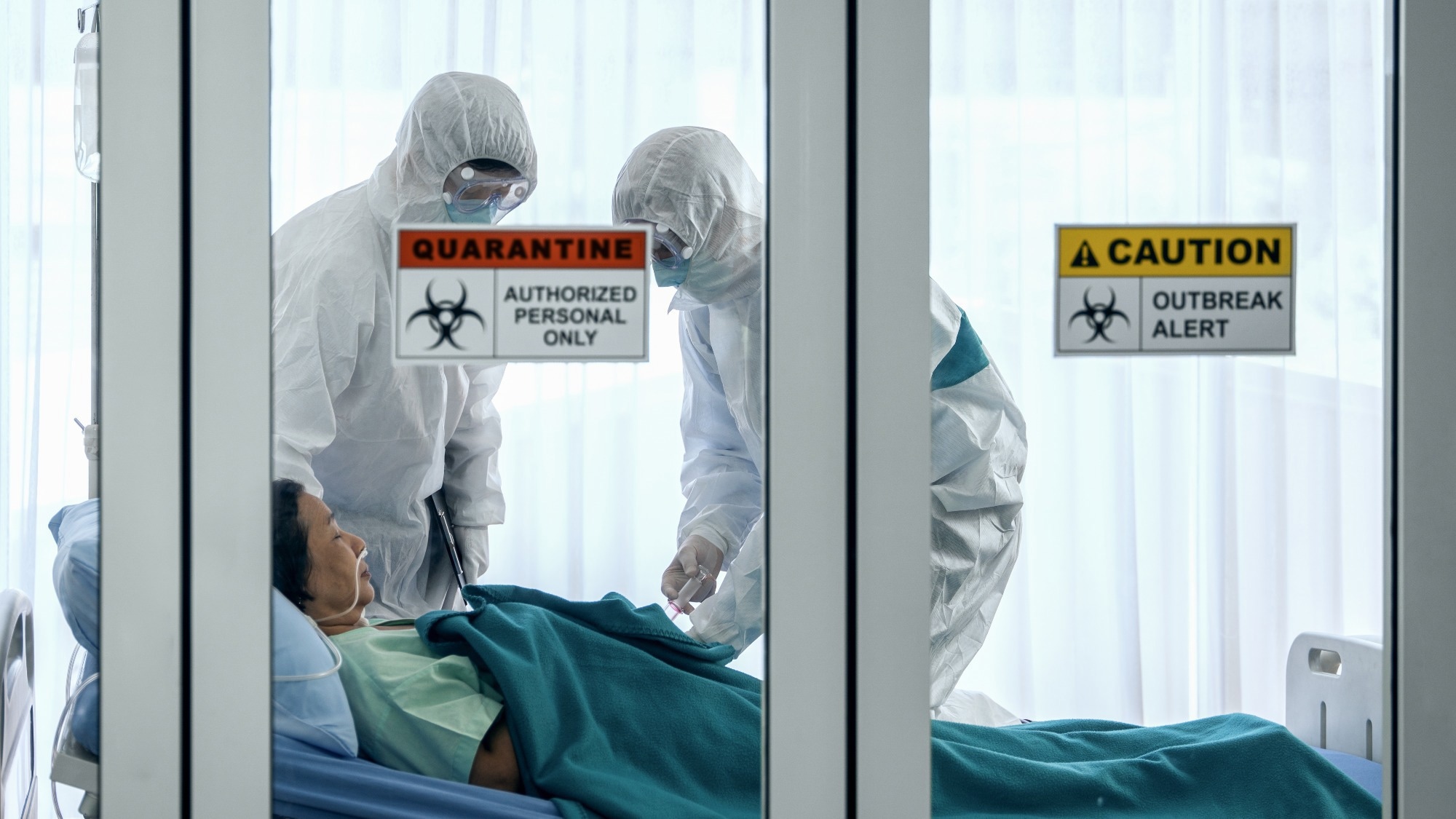In a recent study published in JAMA Network Open, researchers investigated the frequency of hospital-onset coronavirus disease 2019 (COVID-19) cases and the hospital characteristics related to hospital-onset infections by severe acute respiratory syndrome coronavirus 2 (SARS-CoV-2) in the United States (US).
 Study: Assessment of Hospital-Onset SARS-CoV-2 Infection Rates and Testing Practices in the US, 2020-2022. Image Credit: Mongkolchon Akesin/Shutterstock.com
Study: Assessment of Hospital-Onset SARS-CoV-2 Infection Rates and Testing Practices in the US, 2020-2022. Image Credit: Mongkolchon Akesin/Shutterstock.com
Background
The SARS-CoV-2 outbreak has caused considerable disruption globally since 2020.
In the initial COVID-19 wave, hospitals located in the US followed stringent infection control and prevention measures and increased personal protective equipment (PPE) usage (e.g., masking for patients and staff members, SARS-CoV-2 testing for asymptomatic individuals, and N95 respirator and eye protector usage) to curtail SARS-CoV-2 transmission.
Studies have reported a surge in COVID-19 cases during the predominance of the SARS-CoV-2 Omicron variant, linked to a considerable increase in hospital-onset (nosocomial) COVID-19 cases.
The findings indicated a potential elevated risk of contracting SARS-CoV-2 during hospitalization. However, the incidence rates of nosocomial COVID-19 in the US, and related hospital-level variables have not been extensively investigated, warranting further research.
About the study
In the present study, researchers described monthly nosocomial COVID-19 incidence rates during the pandemic and evaluated associations between nosocomial COVID-19 incidence and different COVID-19 periods, SARS-CoV-2 testing practices, causative SARS-CoV-2 strain, and various hospital-level variables.
This study was conducted between July 2020 and June 2022 including COVID-19 testing information submitted by US hospitals to the PINC AI Healthcare Database (PHD). Special release case files dated 30 August 2022 were extracted for analysis.
Data were obtained from hospitals reporting one or more reverse transcription-polymerase chain reaction (RT-PCR) or SARS-CoV-2 antigen tests during hospitalization and analyzed between September 2022 and March 2023.
The study exposure was individuals discharged within the included month of hospitalization.
Multivariate generalized estimating equation (GEE)-based regression modeling was performed to determine the associations between the number of nosocomial COVID-19 cases monthly per 1,000 individual days (described as the initial SARS-CoV-2-positive test after one week of hospitalization) with the COVID-19 period (based on the SARS-CoV-2 strain predominantly in circulation), SARS-CoV-2 testing rates at admission, and hospital-related factors (teaching status, bed size, urban versus rural location, Census area, and variables associated with patient distribution).
SARS-CoV-2 testing rates at admission were calculated as the percentage of hospitalizations with one or more admission tests for every hospital month. The team described admission COVID-19 testing as COVID-19 tests based on reports obtained in the period between seven days before hospital admission and the third day of hospitalization.
The team calculated hospital months based on the monthly admission COVID-19 testing rates. The rates of post-admission SARS-CoV-2 testing were determined based on the number of COVID-19 tests per 1,000 patient days.
Infection onset was considered community-onset in cases where the initial SARS-CoV-2-positive test report was obtained at admission (i.e., before a week off and up to three days of hospitalization), indeterminate-onset in case the initial SARS-CoV-2-positive report was obtained between the fourth and seventh day of hospital admission, and nosocomial or hospital-onset in cases where the initial SARS-CoV-2-positive report was obtained a week after hospitalization.
Results
In total, 5,687 hospital months derived from 288 hospitals contributed to 4,421,268 hospitalization records. Hospitals with less than 200 beds contributed to more than 50% of hospital months [1,744 (31%) from US hospitals with less than 100 beds, and 1,466 (26%) from 100 to 200-bed hospitals].
Among the hospitals, most were situated in the southern parts of the US (55%), predominantly non-teaching (74%), and in the urban regions (66%). COVID-19 waves before Delta strain emergence (i.e., from July 2020 to May 2021) contributed to 49% of the hospital months.
COVID-19 occurred at rates similar to those of other measured healthcare-related infections; among 171,564 hospitalizations with SARS-CoV-2-positive test reports, 7,591 and 6,455 were hospital-onset and indeterminate-onset, respectively. The monthly nosocomial COVID-19 incidence rate per 1,000 individual days per month was 0.3.
Nosocomial COVID-19 occurred in 2,217 hospital months. The monthly proportion of discharged individuals who underwent SARS-CoV-2 testing at hospitalization varied: 1,673 hospital-months below one-quarter of hospital admissions tested for SARS-CoV-2 at admission; 2,199 hospital-months (39%) had one-quarter to one-half of all hospital admissions tested, and 1,815 hospital-months (32%) had greater than one-half of all hospital admissions subjected to COVID-19 testing at admission.
Post-admission rates of SARS-CoV-2 testing and COVID-19 incidence in the community rose with admission SARS-CoV-2 testing rates.
Multivariate modeling showed that higher rates of nosocomial COVID-19 were significantly related to a rise in COVID-19 incidence in the community, COVID-19 period, SARS-CoV-2 testing rates at hospital admission, census regions, and bed sizes.
Multivariate modeling considering hospital months for SARS-CoV-2 testing at one-quarter or more of hospitalizations during admission showed a 10% elevation in COVID-19 incidence in the community related to an increase of 178% in the rate of nosocomial COVID-19 cases (rate ratio, 2.8).
Based on the study findings, increased SARS-CoV-2 surveillance and COVID-19 prevention efforts are required to decrease in-hospital SARS-CoV-2 transmission, especially in the case of high COVID-19 incidence in the community.